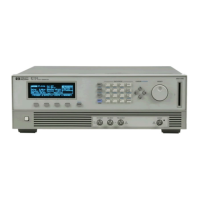1) Overshoot and Ringing
3. Set the digitizing oscilloscope HP 54121T:
n
Press
(KKZZiK)
n
Select the Display menu and set, the Number of Averages to 32
n Select the Channel menu and set the Attenuation factor to 100
n Center one pulse horizontally and vertically on screen (e.g.
TIME/DIV
= 100
ns/div,
DELAY = 800 ns)
H
Select the delta V menu and turn the voltage markers On
H
Set the VARIABLE LEVELS = 95%
-
105% and press
@JTO
LEVEL SET]
n Select the channel menu and center vertically the top pulse
(offset = 25 V)
n Set the
VOLTSDIV
= 1
V/div
n Select the
Timebase
menu and set
TIMEiDIV
= 20
ns/div,
DELAY = 30 ns
4. Check that Overshoot and Ringing are within the
f5%
of
amplitude
lt50
mV
window (within the two marker positions)
5. Enter the result in the Test Report as TR entry 9 I
Note
1
Q
lake the oscilloscope’s trace flatness error
(GaAs
input circuit) into
account.
6. Set HP 8114A to: Amplitude = 5 V
7. Repeat steps 3 to 5, but this time set the Scope to:
w
VARIABLE LEVELS = 94%
-
106% and press [AUTO LEVEL SET]
n
OFFSET = 5 V
m
VOLTSDIV
= 200 mV/Div
m
TIMEBASE
= 20
ns/Div
8. Enter the result in the Test Report as TR entry 9
-
2
2) Preshoot
9. Set HP 8114A to:
l Period = 1
ps
l Amplitude = 5
V,
m
Baseline = 0 V
n Delay = 50
ns
10. Set the digitizing oscilloscope, HP 54121T:
l
Press
(iii]
l Select the Display menu and set the Number of Averages to 32
l Select the Channel menu and set the Attenuation factor to 100
n Center one pulse horizontally and vertically on screen (e.g.
TIME/DIV
= 100
ns/div,
DELAY = 800 ns)
n Select the delta V menu and turn the voltage markers On
n Set the VARIABLE LEVELS = -6% to
+6%
and press
(AUTO LEVEL SET)
n Select the channel menu and center vertically the bottom of the
pulse (offset = 0 V)
n Set the
VOLTSDIV
= 200 mV/div
m
Select the
Timebase
menu and set
TIME/DIV
= 20
ns/div
3.42
Testing the HP
8114A

